a/k/a... My Trip to Peru
When most people think of Peru, they think of Machu Picchu. But how much do you know about the country’s other sights? To get a true sense of all that Peru has to offer, be prepared to travel through cities, over mountains, into valleys and maybe even across the world’s highest navigable lake! I recently posted about Machu Picchu. It is deserving of its own write-up! (Click to learn about the UNESCO World Heritage site). Or, read on to learn about some of the other travel destinations in Peru.
 The Andes MountainsThe clouds create variety in the scene on a daily basis.
The Andes MountainsThe clouds create variety in the scene on a daily basis.
Our trip began in Lima, Peru’s capital and largest city. It is also the second largest city in South America, behind São Paulo, Brazil. Our plane arrived late in the evening, so we decided to spend our first full day in Lima, taking a city tour and exploring a bit on our own. We especially enjoyed the incredible architecture of the city’s Historic Center and the beautiful sunset at the Parque del Amor (Love Park) along the Peruvian coastline. The district of Miraflores is home to excellent hotels and restaurants. We found the El Pardo Doubletree to have outstanding accommodations and service. It was easy finding our first Peruvian meal. The hotel recommended the restaurant, Panchita, right around the corner. We quickly became fans of Lomo Saltado and Pisco Sours!
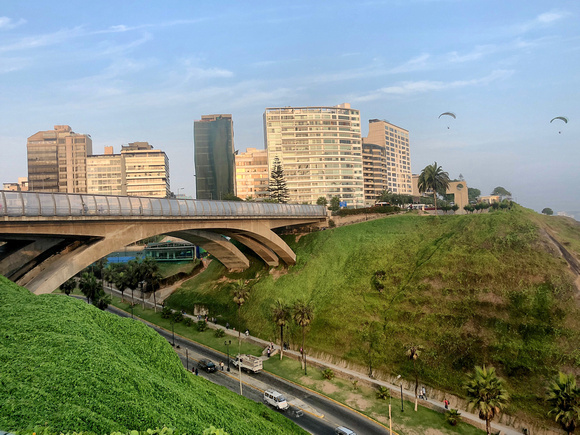 Lima Skyline
Lima Skyline
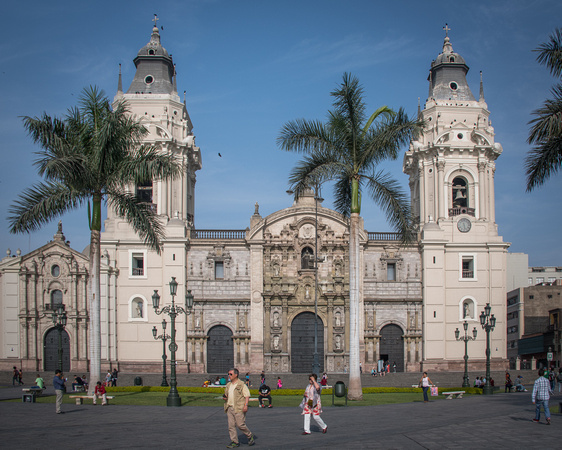 Lima ArchitecturePlaza de Armas
Lima ArchitecturePlaza de Armas
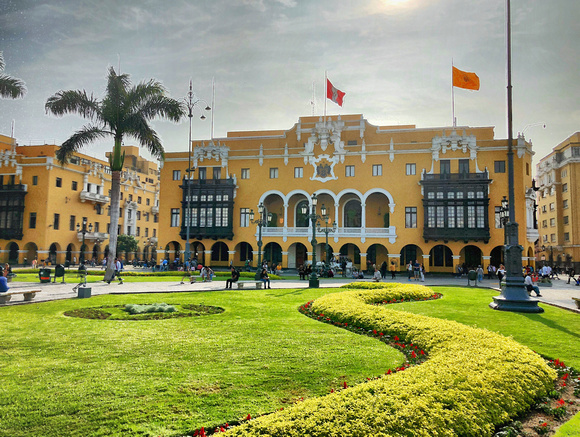 Lima ArchitecturePlaza de Armas
Lima ArchitecturePlaza de Armas
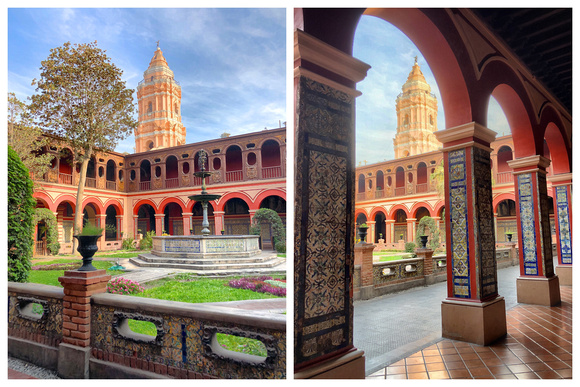 Convent of Santo Domingo
Convent of Santo Domingo
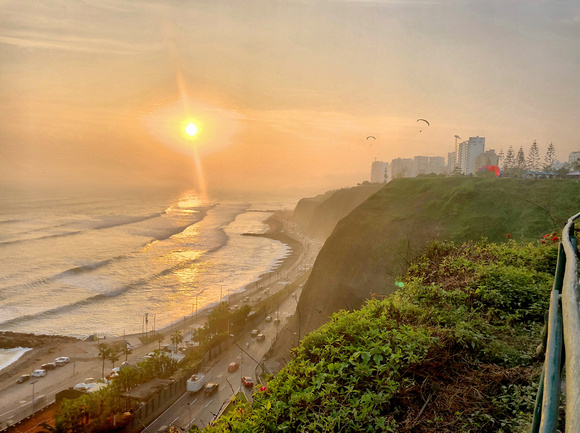 Sunset from Parque del Amor
Sunset from Parque del Amor
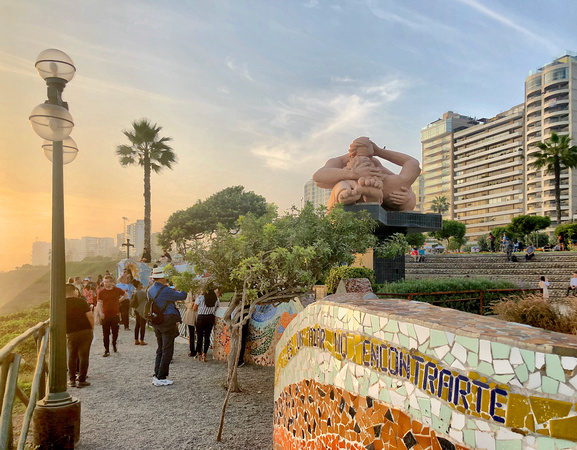 Sunset at Parque del Amor
Sunset at Parque del Amor
After Lima, we spent two nights in the Sacred Valley. Our stay at the Casa Andina in Urubamba proved the perfect base for the area’s attractions.
 Casa Andina Hotel groundsUrubamba
Casa Andina Hotel groundsUrubamba
Our first destination was Maras and the Marasal Salt Pools, set along a mountain hillside. The Incans originally created the pools in the 1400s, when they discovered rich salt deposits in the mountain and a natural stream flowing down its side. They created shallow pools at the base of the mountain to capture the salt rich water. After filling, the pools are damned to allow the water to evaporate. Crystals are then harvested, bagged and taken to market. Today, a collaborative of local families from the Maras community harvest the salt. Families wishing to participate take charge of individual pools, but they must consult with the collaborative to ensure the process maintains market standards. The overall process remains largely unchanged since the early days.
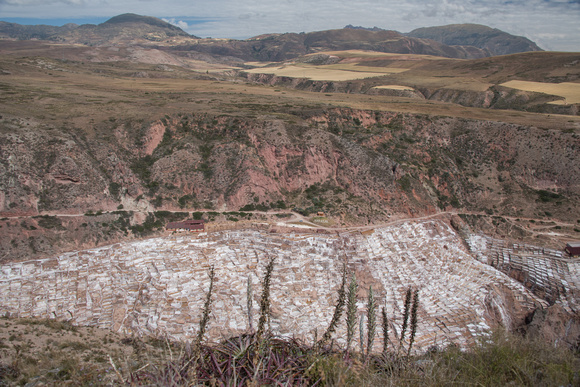 Marasal Salt Pools/Pans
Marasal Salt Pools/Pans
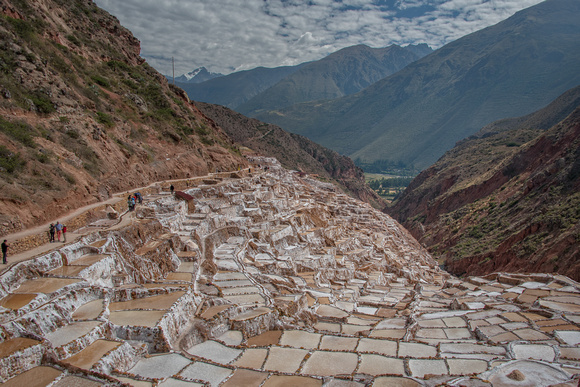 The Salt Pools/Pans
The Salt Pools/Pans
 Mountain Spring WaterMaras is a hillside town in the Sacred Valley of Peru and home to the Marasal salt mines dating back to Incan times.
Mountain Spring WaterMaras is a hillside town in the Sacred Valley of Peru and home to the Marasal salt mines dating back to Incan times.
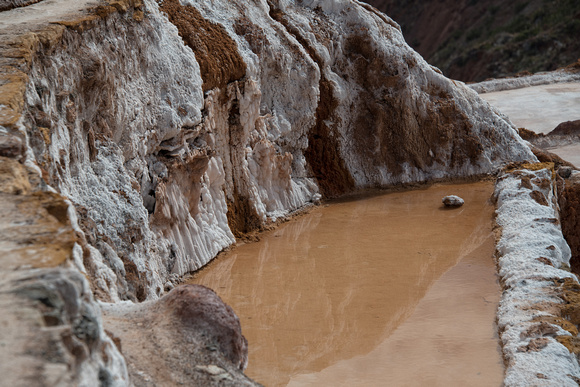 Pool of Salt Water
Pool of Salt Water
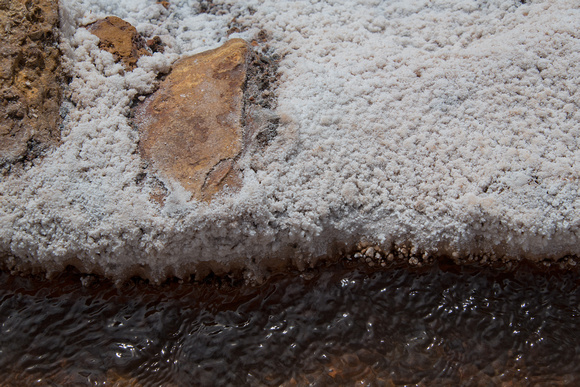 Marasal SaltMaras is a hillside town in the Sacred Valley of Peru and home to the Marasal salt mines dating back to Incan times.
Marasal SaltMaras is a hillside town in the Sacred Valley of Peru and home to the Marasal salt mines dating back to Incan times.
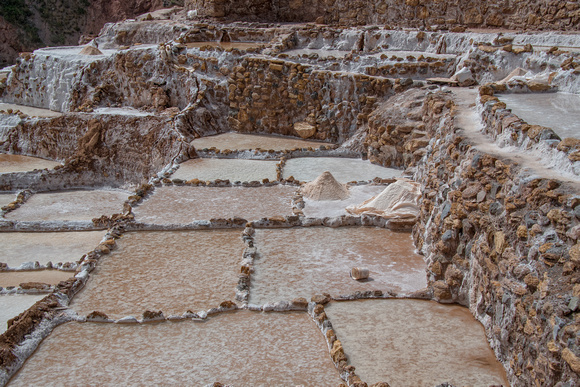 Close Up on the Marasal PansMaras is a hillside town in the Sacred Valley of Peru and home to the Marasal salt mines dating back to Incan times.
Close Up on the Marasal PansMaras is a hillside town in the Sacred Valley of Peru and home to the Marasal salt mines dating back to Incan times.
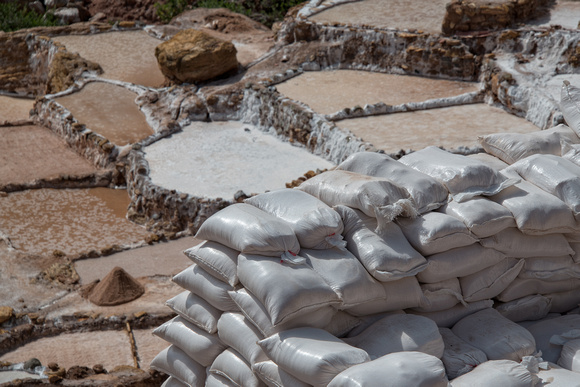 Bagging Marasal's SaltMaras is a hillside town in the Sacred Valley of Peru and home to the Marasal salt mines dating back to Incan times.
Bagging Marasal's SaltMaras is a hillside town in the Sacred Valley of Peru and home to the Marasal salt mines dating back to Incan times.
Our next destination, Moray, was our first up-close encounter with the country’s fascinating agricultural terraces. Moray’s circular terraces, filled with fertile earth and a complex irrigation system, form sunken amphitheatres. It is thought that the Incas used the site for research to experiment with crops at various altitudes.
 Moray Agricultural TerracesMoray is a town to the west of Maras in the Sacred Valley of southeastern Peru. It is known for its circular and well-preserved agricultural terraces filled with fertile earth, a complex irrigation system and sunken amphitheaters. The site is thought to have been used by the Incas for research to experiment with crops at various altitudes.
Moray Agricultural TerracesMoray is a town to the west of Maras in the Sacred Valley of southeastern Peru. It is known for its circular and well-preserved agricultural terraces filled with fertile earth, a complex irrigation system and sunken amphitheaters. The site is thought to have been used by the Incas for research to experiment with crops at various altitudes.
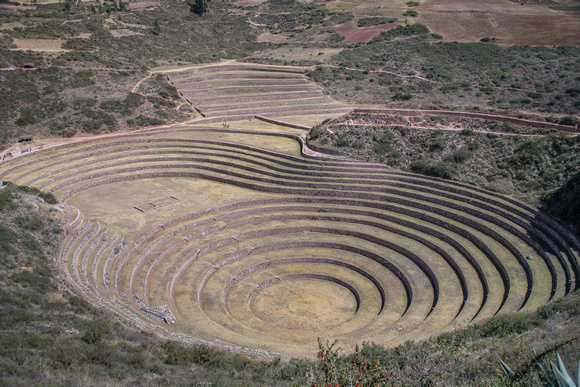 Moray Agricultural TerracesMoray is a town to the west of Maras in the Sacred Valley of southeastern Peru. It is known for its circular and well-preserved agricultural terraces filled with fertile earth, a complex irrigation system and sunken amphitheaters. The site is thought to have been used by the Incas for research to experiment with crops at various altitudes.
Moray Agricultural TerracesMoray is a town to the west of Maras in the Sacred Valley of southeastern Peru. It is known for its circular and well-preserved agricultural terraces filled with fertile earth, a complex irrigation system and sunken amphitheaters. The site is thought to have been used by the Incas for research to experiment with crops at various altitudes.
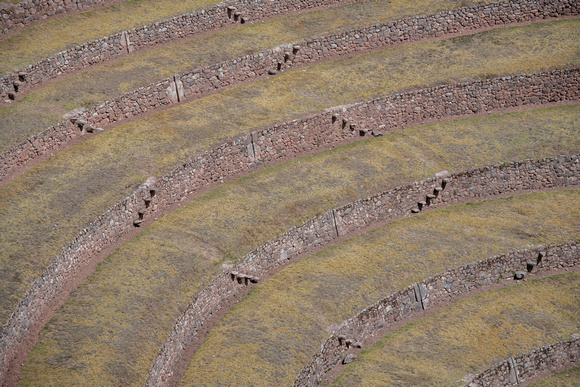 Terrace StairsDiagonally placed stones along the walls serve as stairs to the various terraces.
Terrace StairsDiagonally placed stones along the walls serve as stairs to the various terraces.
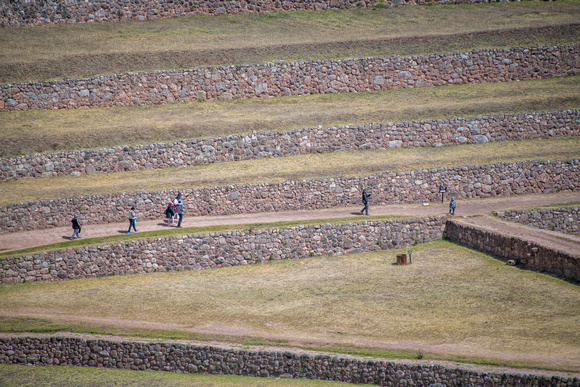 Walking Amidst the TerracesMoray
Walking Amidst the TerracesMoray
Let's take a break from the destinations to talk about lunch. It was that time, after all! Our tour guide asked us if we were interested in a local experience. Keep in mind, we were driving through small towns of the Sacred Valley at this point.
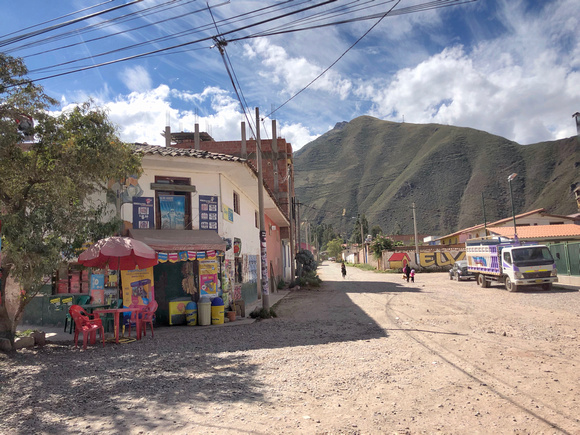 Traveling Through the Small Towns...of the Sacred Valley
Traveling Through the Small Towns...of the Sacred Valley
 Traveling Through the Small Towns...of the Sacred Valley
Traveling Through the Small Towns...of the Sacred Valley
 Traveling Through the Small Towns...of the Sacred Valley
Traveling Through the Small Towns...of the Sacred Valley
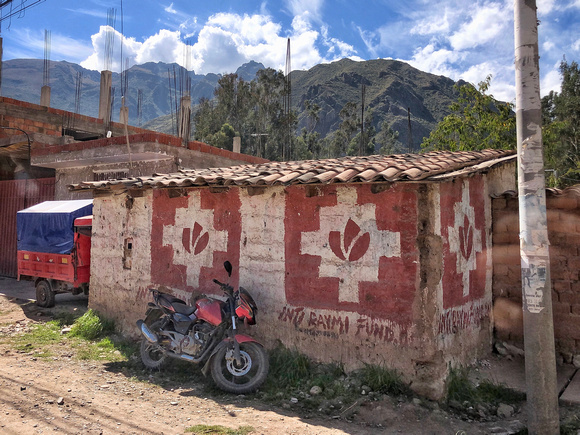 Traveling Through the Small Towns...of the Sacred Valley
Traveling Through the Small Towns...of the Sacred Valley
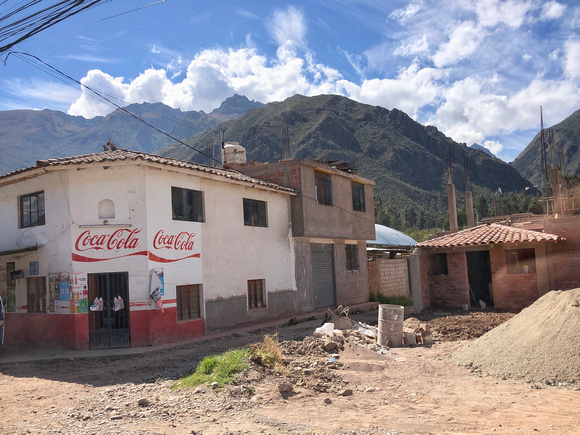 Traveling Through the Small Towns...of the Sacred Valley
Traveling Through the Small Towns...of the Sacred Valley
 Traveling Through the Small Towns...of the Sacred Valley
Traveling Through the Small Towns...of the Sacred Valley
We weren't seeing a lot of tourists. If we truly wanted authentic, this was the time. Her suggestion was to stop for cuy (pronounced “kwee”) - guinea pig! The small mammal has been a part of Peru’s Andean diet for 5,000 years. My first thought was of the pet guinea pig we kept in the classroom during those days that I taught preschool. In Peru, however, the animal is a delicacy, served on special occasions and to special guests. Were we special guests? I suppose it would be rude to say “no” – and my adult sons were on board to try it!
As we entered the small roadside restaurant, our guide pointed out the guineas roasting on skewers in an adobe oven. She spoke briefly with the owner, then told us that she requested our cuy be cut into pieces. I wondered a bit why she felt the need to point that out. Then, I noticed that other restaurant guests (locals) were being served plates with whole roasted guineas on top. At that point, I truly appreciated our tour guide! In fact, later in our trip, I met a Floridian traveler who told me about her cuy experience at a more touristy restaurant. The guinea there was served whole and dressed in costume with a hat atop! Yikes! I was happy to have had the local experience! How was it? The meat was seasoned well and flavorful, but there was not much meat on the bones. It was served with an abundance of potatoes and vegetables and all were quite tasty. Yes, I was initially the most apprehensive of our group, but I left pleased to have tried the experience.
We were ready for our next destination, the Incan ruins above Pisac. It is one of the Sacred Valley’s most important sites for Incan ruins, as they are part of a larger Incan platform and urban planning system, very advanced for its time. We learned about Incan architecture, agricultural terraces, an Incan hydraulic system, a military fortress, residential structures and religious customs.
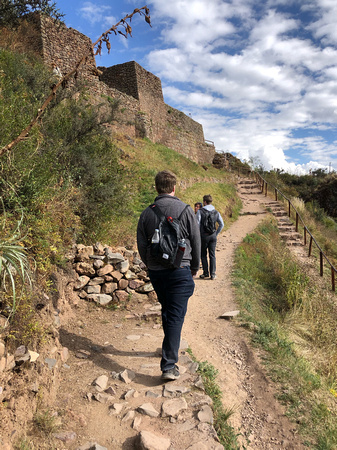 Path to the RuinsThe Sacred Valley, or Urubamba Valley, of Peru is located in the highlands of the Andean mountains. It is home to the Spanish colonial villages of Pisac and Ollantaytambo. Travelers looking for shopping opportunities will be happy with Pisac's large handicraft market. At the top of Pisac's hillside, travelers will find one of the Sacred Valley’s most important sites for Incan ruins. This hillside citadel is an example of an Incan platform and urban planning system, very advanced for its time. It includes Incan architecture, agricultural terraces, an Incan hydraulic system, a military fortress, as well as residential and religious structures.
Path to the RuinsThe Sacred Valley, or Urubamba Valley, of Peru is located in the highlands of the Andean mountains. It is home to the Spanish colonial villages of Pisac and Ollantaytambo. Travelers looking for shopping opportunities will be happy with Pisac's large handicraft market. At the top of Pisac's hillside, travelers will find one of the Sacred Valley’s most important sites for Incan ruins. This hillside citadel is an example of an Incan platform and urban planning system, very advanced for its time. It includes Incan architecture, agricultural terraces, an Incan hydraulic system, a military fortress, as well as residential and religious structures.
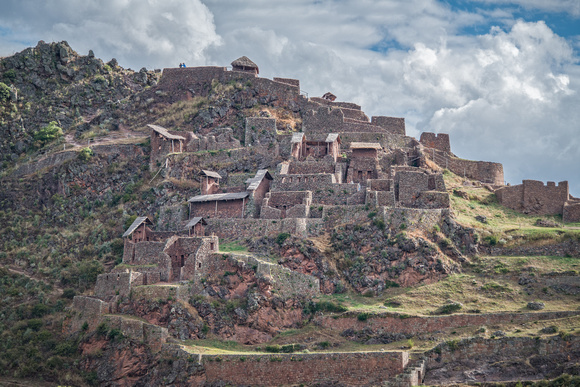 Archaeological Ruins above Pisac
Archaeological Ruins above Pisac
 Agricultural Terraces Above PisacThe Sacred Valley, or Urubamba Valley, of Peru is located in the highlands of the Andean mountains. It is home to the Spanish colonial villages of Pisac and Ollantaytambo. Travelers looking for shopping opportunities will be happy with Pisac's large handicraft market. At the top of Pisac's hillside, travelers will find one of the Sacred Valley’s most important sites for Incan ruins. This hillside citadel is an example of an Incan platform and urban planning system, very advanced for its time. It includes Incan architecture, agricultural terraces, an Incan hydraulic system, a military fortress, as well as residential and religious structures.
Agricultural Terraces Above PisacThe Sacred Valley, or Urubamba Valley, of Peru is located in the highlands of the Andean mountains. It is home to the Spanish colonial villages of Pisac and Ollantaytambo. Travelers looking for shopping opportunities will be happy with Pisac's large handicraft market. At the top of Pisac's hillside, travelers will find one of the Sacred Valley’s most important sites for Incan ruins. This hillside citadel is an example of an Incan platform and urban planning system, very advanced for its time. It includes Incan architecture, agricultural terraces, an Incan hydraulic system, a military fortress, as well as residential and religious structures.
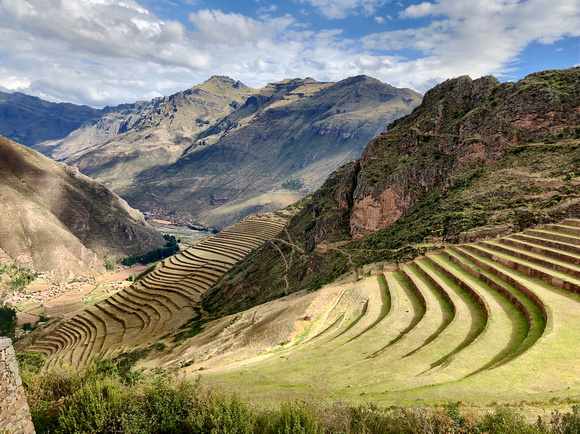 Agricultural Terraces Above PisacThe Sacred Valley, or Urubamba Valley, of Peru is located in the highlands of the Andean mountains. It is home to the Spanish colonial villages of Pisac and Ollantaytambo. Travelers looking for shopping opportunities will be happy with Pisac's large handicraft market. At the top of Pisac's hillside, travelers will find one of the Sacred Valley’s most important sites for Incan ruins. This hillside citadel is an example of an Incan platform and urban planning system, very advanced for its time. It includes Incan architecture, agricultural terraces, an Incan hydraulic system, a military fortress, as well as residential and religious structures.
Agricultural Terraces Above PisacThe Sacred Valley, or Urubamba Valley, of Peru is located in the highlands of the Andean mountains. It is home to the Spanish colonial villages of Pisac and Ollantaytambo. Travelers looking for shopping opportunities will be happy with Pisac's large handicraft market. At the top of Pisac's hillside, travelers will find one of the Sacred Valley’s most important sites for Incan ruins. This hillside citadel is an example of an Incan platform and urban planning system, very advanced for its time. It includes Incan architecture, agricultural terraces, an Incan hydraulic system, a military fortress, as well as residential and religious structures.
Our guide pointed out a school in the town of Pisac, below the complex, as well as modern day homes above the complex and told us a bit about rural life in these communities. When residents from above need to go into town, many walk up and down the mountainside. We saw no bikes. It is simply too hilly. We did see a young girl walking home from school on a path alongside the complex. Our tour guide asked her how long it takes to walk home. She told us an hour and a half!
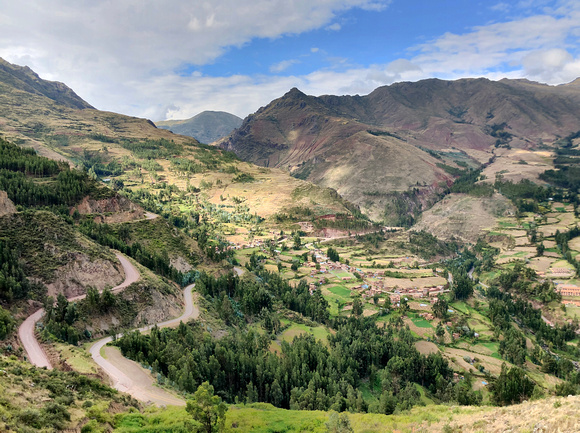 Pisac From AboveiPhone photo
Pisac From AboveiPhone photo
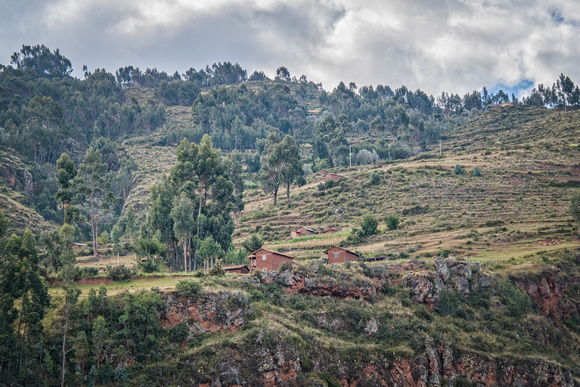 Homes At the Top... above Pisac's archaeological ruins site
Homes At the Top... above Pisac's archaeological ruins site
We also visited Pisac and its Indian Market. The town is one of the best places to find products made by local craftspeople. Alpaca wool, silversmithing and ceramics are abundant. Our guide gave us some free time, but suggested a stop at the Geraldine Factory if we were interested in learning some of the processes behind the crafts. We took her up on the suggestion and learned how to spot true “baby alpaca” wool and high quality silver while shopping among the country’s craftspeople. Baby alpaca wool, by the way, comes from the alpaca’s first shearing and is some of the softest wool you will find!
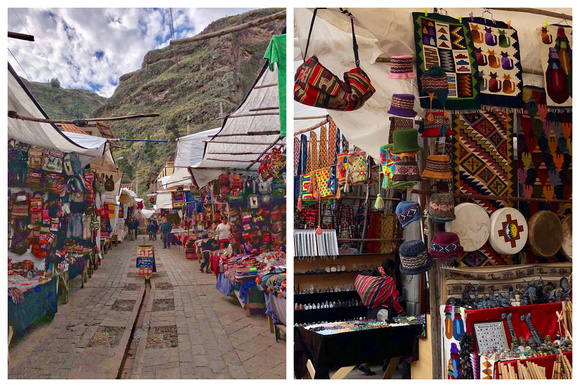 Pisac Indian MarketThe Sacred Valley, or Urubamba Valley, of Peru is located in the highlands of the Andean mountains.
Pisac Indian MarketThe Sacred Valley, or Urubamba Valley, of Peru is located in the highlands of the Andean mountains.
If you’ve been following my Peruvian travels, you know that we spent the next two days in Machu Picchu. Again, I felt the destination to be worthy of its own posts. If you’d like more information, click to learn about Machu Picchu itself, or about the unique planning required for such a trip. Here, I’ll simply add that we stayed one night at The Sumaq Machu Picchu Hotel in Aguas Calientes. It was probably our favorite hotel of the trip and worth researching when planning an overnight stay in the town.
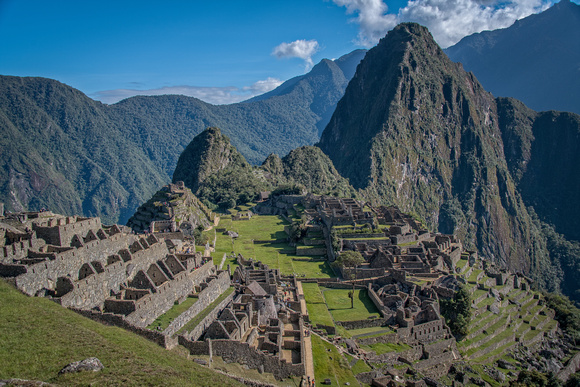 Machu PicchuMachu Picchu, a UNESCO World Heritage site, is thought to be one of the world’s most significant archaeological discoveries in recent history, largely because of the amount of knowledge it has revealed about Inca civilization. This "Lost City of the Incas" is located on the eastern slopes of the Andes mountains, near the low-lying Amazon basin.
Machu PicchuMachu Picchu, a UNESCO World Heritage site, is thought to be one of the world’s most significant archaeological discoveries in recent history, largely because of the amount of knowledge it has revealed about Inca civilization. This "Lost City of the Incas" is located on the eastern slopes of the Andes mountains, near the low-lying Amazon basin.
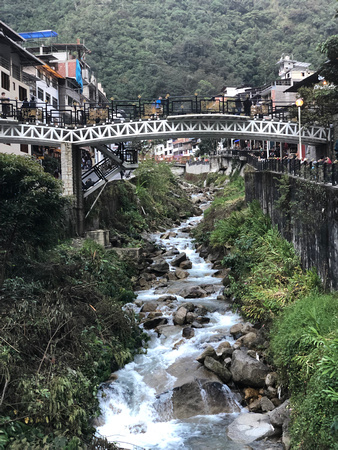 Aguas Calientes... at the base of Machu Picchu
Aguas Calientes... at the base of Machu Picchu
Cusco was the perfect destination after a visit to Machu Picchu. A city with a population of just under 500,000, it is set at 11,000 feet above sea level, high in the Peruvian Andes. We stayed at the Hotel Novotel Cusco, near the city’s historic center. Walking through streets filled with historic architecture, we quickly realized that many of the buildings had foundations made of the same Incan architecture that we saw in Machu Picchu – architecture that has withstood centuries of time - and major earthquakes! Our hotel, built in the 16th century, was one such building. Architecturally, this was probably the most interesting of our hotel accommodations. Although the hotel wasn’t quite as luxurious as the newer hotels where we stayed, it was updated and quite comfortable.
 CuscoCusco
CuscoCusco
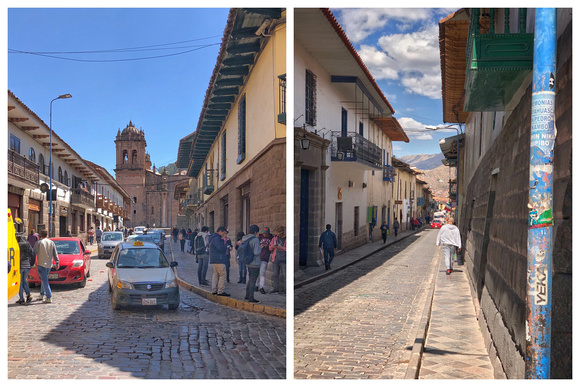 Walking Through CuscoIncan architecture serves as the foundation for many buildings around the city's historic district.
Walking Through CuscoIncan architecture serves as the foundation for many buildings around the city's historic district.
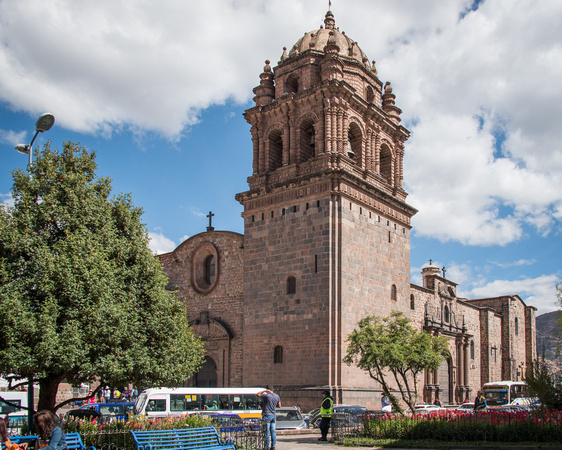 Koricancha TempleRuins from this ancient Inca palace and temple for the Sun God were subsequently used as the foundation for a dominican church. Today, the Santo Domingo Church is an impressive example of both Incan and Spanish architecture.
Koricancha TempleRuins from this ancient Inca palace and temple for the Sun God were subsequently used as the foundation for a dominican church. Today, the Santo Domingo Church is an impressive example of both Incan and Spanish architecture.
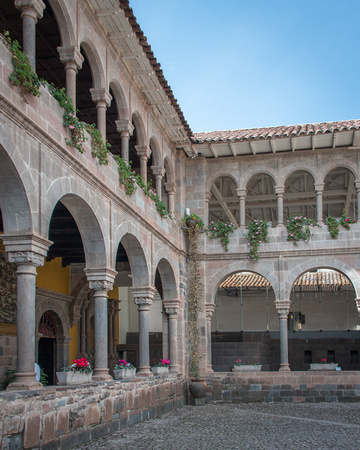 Koricancha TempleAn Incan foundation is spotted just past the Archways. Spanish architecture was built above the foundation.
Koricancha TempleAn Incan foundation is spotted just past the Archways. Spanish architecture was built above the foundation.
 Koricancha TempleDoorway
Koricancha TempleDoorway
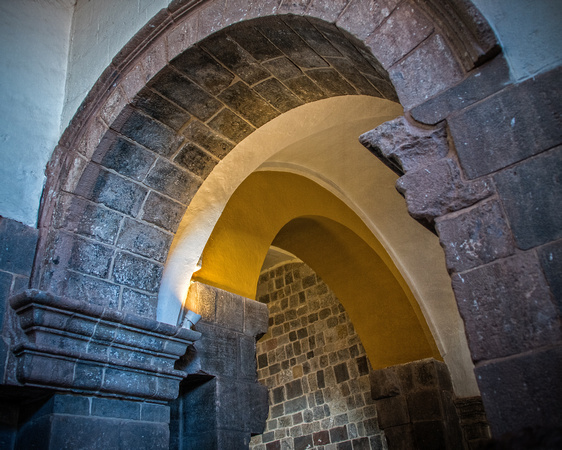 Koricancha TempleSpanish archways of the Santo Domingo Church, built above the ruins/foundation of an ancient Inca palace and temple for the Sun God.
Koricancha TempleSpanish archways of the Santo Domingo Church, built above the ruins/foundation of an ancient Inca palace and temple for the Sun God.
 A View of Cuscofrom the Koricancha Temple
A View of Cuscofrom the Koricancha Temple
 Fortress of Sacsayhuaman...watching over Cusco
Fortress of Sacsayhuaman...watching over Cusco
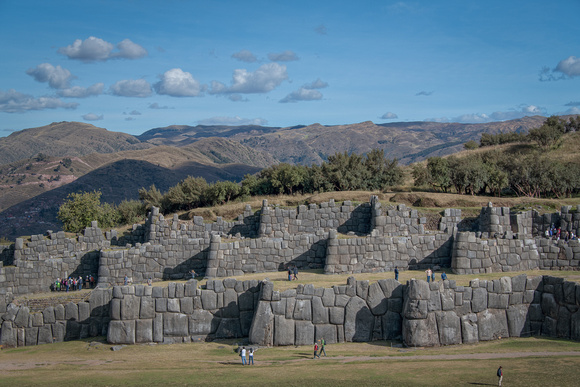 Fortress of Sacsayhuaman... high atop the city of Cusco, Peru.
Fortress of Sacsayhuaman... high atop the city of Cusco, Peru.
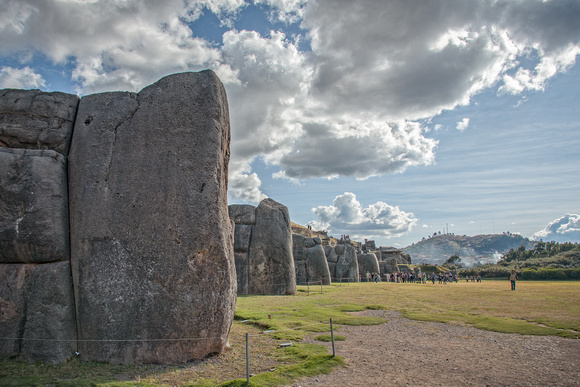 Fortress of Sacsayhuaman... high atop the city of Cusco, Peru
Fortress of Sacsayhuaman... high atop the city of Cusco, Peru
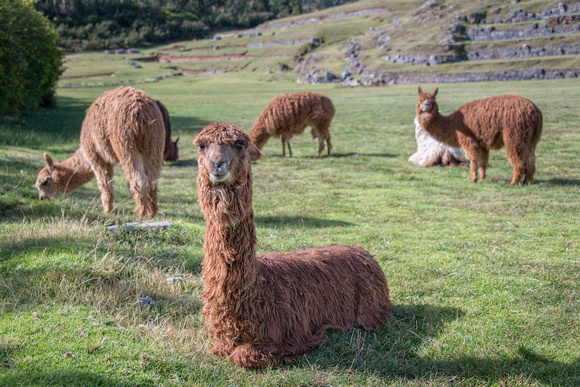 Alpacasat the fortress
Alpacasat the fortress
 Puca Pucara...the resting place of the Inca; high above the city of Cusco, Peru
Puca Pucara...the resting place of the Inca; high above the city of Cusco, Peru
As in Lima, we took a city tour and explored on our own, as much as time allowed. We saw some incredible sights, but we wished we had allocated more time to Cusco! One full day was simply not enough! We really enjoyed learning about the architecture of Machu Picchu and were thrilled to find the Machu Picchu Museum right around the corner from our hotel. An evening walk around the Plaza de Armas main square was a highlight.
 Plaza de ArmasCusco's Main Square
Plaza de ArmasCusco's Main Square 
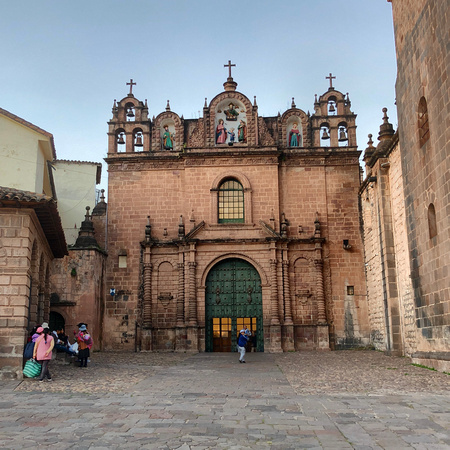 Across from the Plaza de ArmasCusco's Main Square
Across from the Plaza de ArmasCusco's Main Square 
 Across from Plaza de ArmasCusco's Main Square
Across from Plaza de ArmasCusco's Main Square
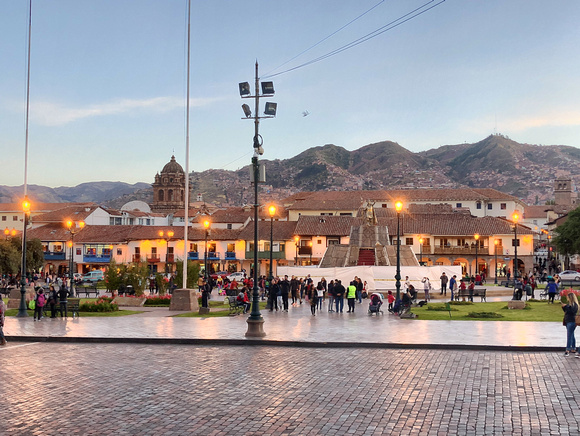 Plaza de ArmasCusco's Main Square
Plaza de ArmasCusco's Main Square
Restaurants were also plentiful. We stumbled across one of our favorite restaurants, called A Mi Manera, on a 2nd floor balcony of sorts, overlooking a small town square. The restaurant had wonderful Peruvian food, service and ambiance!
 DinnertimeCusco is located in the southeastern area of Peru, high in the Andes mountain range and near Peru's Sacred Valley. Formerly a capital city, it is now known for Incan archaeological ruins and Spanish colonial architecture.
DinnertimeCusco is located in the southeastern area of Peru, high in the Andes mountain range and near Peru's Sacred Valley. Formerly a capital city, it is now known for Incan archaeological ruins and Spanish colonial architecture.
The final two days of our journey were spent near the city of Puno, in southeastern Peru at 12,500 feet above sea level and on the shore of the world’s highest navigable lake, Lake Titicaca.
 View of PunoLake Titicaca is one of South America's largest lakes and the world's highest navigable lake. Bordering both Peru and Bolivia, travelers to the lake discover both natural islands, made of earth, and man-made islands, made of reeds that grow at the bottom of the lake. Residents of the floating Uros Islands, or "Reed Islands", harvest the reeds from the lake and use them to build and maintain the islands themselves, as well as their homes, boats, furniture, and most everything they need to live on the islands. Residents of both types of islands maintain a way life resembling that of their Inca and pre-Inca ancestors.
View of PunoLake Titicaca is one of South America's largest lakes and the world's highest navigable lake. Bordering both Peru and Bolivia, travelers to the lake discover both natural islands, made of earth, and man-made islands, made of reeds that grow at the bottom of the lake. Residents of the floating Uros Islands, or "Reed Islands", harvest the reeds from the lake and use them to build and maintain the islands themselves, as well as their homes, boats, furniture, and most everything they need to live on the islands. Residents of both types of islands maintain a way life resembling that of their Inca and pre-Inca ancestors.
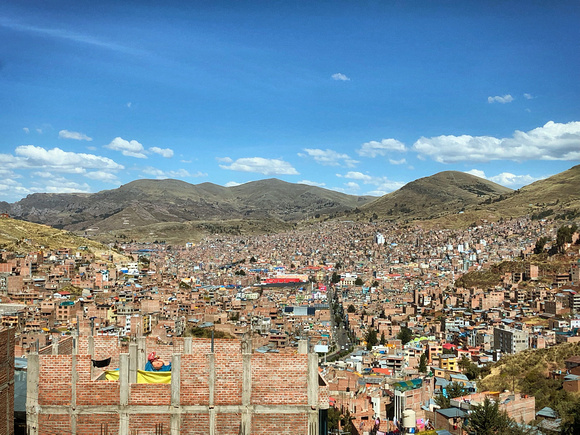 PunoCity at the shore of Lake Titicaca, in Peru
PunoCity at the shore of Lake Titicaca, in Peru
We began by checking into our hotel, the Casa Andina Puno, at the water’s edge. We were used to hotel greeters pointing out hotel amenities on check-in. This was the first time, however, that a greeter pointed out the supplemental oxygen available on request! Once again, we felt that higher altitude!
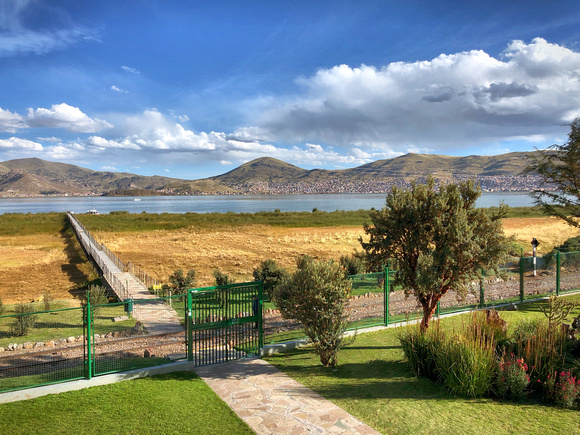 Entrance to the Marina...from the Casa Andina Puno
Entrance to the Marina...from the Casa Andina Puno
On our first full day, we met our guide and driver at the hotel marina. Today, we would be traveling by boat! Our destinations were Amantani and the Uros Islands, where inhabitants still cling to a way of life, much like that of their Inca and pre-Inca ancestors.
 Sailing Through the Reedsof Lake Titicaca (from Puno)
Sailing Through the Reedsof Lake Titicaca (from Puno)
The best known of the islands and our favorite destination of the trip (behind only Machu Picchu) were the Uros Islands, also known as the Floating Islands. The islands are man-made, built from the reed that grows at the bottom of the lake. And, yes, the islands actually do float - anchors keep them from floating away! Homes, furnishings and boats are all made of reed. Island surfaces are a bit spongy to walk on and need constant maintenance, given that the lower layers of reed are in water and decay regularly. Islanders spend much of their time replacing decaying reed. It is not an easy life. There is also no running water and temperatures frequently dip to freezing at night.
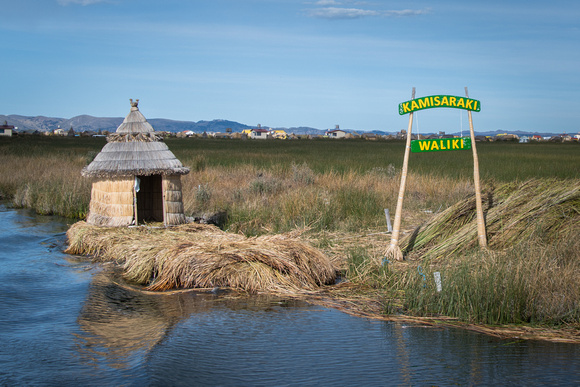 Welcome to the Uros IslandsLake Titicaca is one of South America's largest lakes and the world's highest navigable lake. Bordering both Peru and Bolivia, travelers to the lake discover both natural islands, made of earth, and man-made islands, made of reeds that grow at the bottom of the lake. Residents of the floating Uros Islands, or "Reed Islands", harvest the reeds from the lake and use them to build and maintain the islands themselves, as well as their homes, boats, furniture, and most everything they need to live on the islands. Residents of both types of islands maintain a way life resembling that of their Inca and pre-Inca ancestors.
Welcome to the Uros IslandsLake Titicaca is one of South America's largest lakes and the world's highest navigable lake. Bordering both Peru and Bolivia, travelers to the lake discover both natural islands, made of earth, and man-made islands, made of reeds that grow at the bottom of the lake. Residents of the floating Uros Islands, or "Reed Islands", harvest the reeds from the lake and use them to build and maintain the islands themselves, as well as their homes, boats, furniture, and most everything they need to live on the islands. Residents of both types of islands maintain a way life resembling that of their Inca and pre-Inca ancestors.
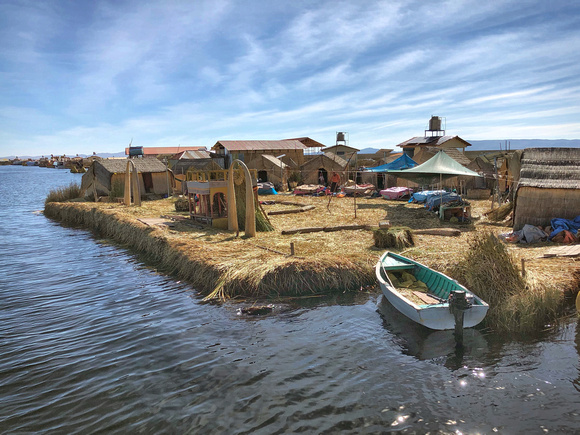 Visiting the Uros IslandsLake Titicaca is one of South America's largest lakes and the world's highest navigable lake. Bordering both Peru and Bolivia, travelers to the lake discover both natural islands, made of earth, and man-made islands, made of reeds that grow at the bottom of the lake. Residents of the floating Uros Islands, or "Reed Islands", harvest the reeds from the lake and use them to build and maintain the islands themselves, as well as their homes, boats, furniture, and most everything they need to live on the islands. Residents of both types of islands maintain a way life resembling that of their Inca and pre-Inca ancestors.
Visiting the Uros IslandsLake Titicaca is one of South America's largest lakes and the world's highest navigable lake. Bordering both Peru and Bolivia, travelers to the lake discover both natural islands, made of earth, and man-made islands, made of reeds that grow at the bottom of the lake. Residents of the floating Uros Islands, or "Reed Islands", harvest the reeds from the lake and use them to build and maintain the islands themselves, as well as their homes, boats, furniture, and most everything they need to live on the islands. Residents of both types of islands maintain a way life resembling that of their Inca and pre-Inca ancestors.
 Uros Islands...floating reed islands on Lake Titicaca
Uros Islands...floating reed islands on Lake Titicaca
 Reed Boat
Reed Boat
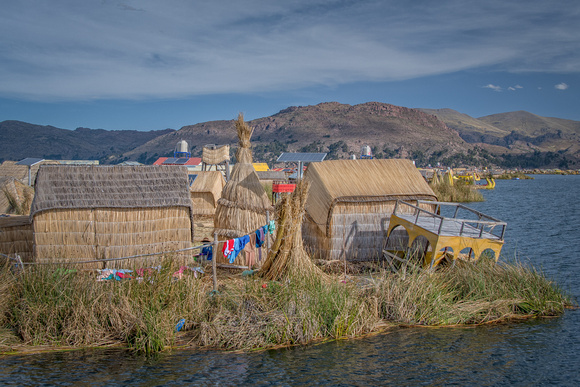 Uros Islands...floating reed islands on Lake Titicaca
Uros Islands...floating reed islands on Lake Titicaca
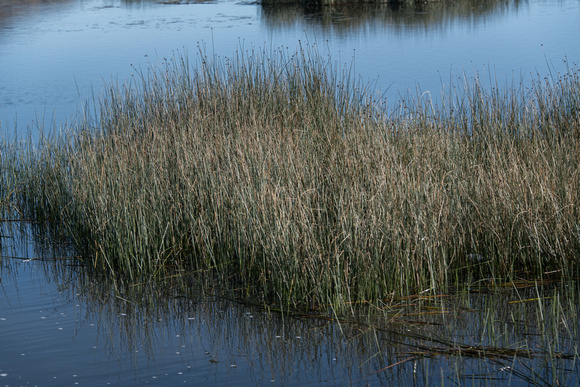 Close Up on the ReedsLake Titicaca
Close Up on the ReedsLake Titicaca
There are close to 50 floating islands, most of which remain untouched by visitors. There is a growing trend to welcome tourists, however. Islanders are known to be friendly, hospitable, and quite colorful in attire! Our small family was thrilled to be welcomed onto an island of only five families and 25 inhabitants who lived up to that friendly reputation! Speaking in Aymara, the leader of the island used tools and small models of reed structures to demonstrate how the islands are built. Our tour guide translated, but the leader’s theatrical personality had us laughing and enjoying the presentation, even without the translation! His wife invited us into their small one-room home, showing us their reed furnishings and the handicrafts that fill her day. She seemed most proud to show us the electricity that they enjoy, thanks to solar panels! Our hosts ended the visit by offering us a ride on one of their reed boats. The Uro islanders are truly a hard-working, but happy and remarkable people!
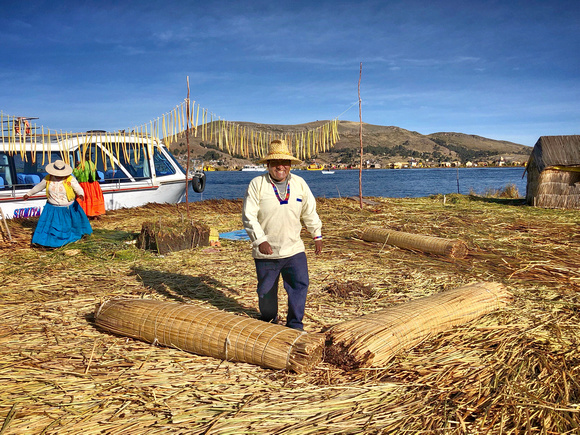 Reed "Couches"Lake Titicaca is one of South America's largest lakes and the world's highest navigable lake. Bordering both Peru and Bolivia, travelers to the lake discover both natural islands, made of earth, and man-made islands, made of reeds that grow at the bottom of the lake. Residents of the floating Uros Islands, or "Reed Islands", harvest the reeds from the lake and use them to build and maintain the islands themselves, as well as their homes, boats, furniture, and most everything they need to live on the islands. Residents of both types of islands maintain a way life resembling that of their Inca and pre-Inca ancestors.
Reed "Couches"Lake Titicaca is one of South America's largest lakes and the world's highest navigable lake. Bordering both Peru and Bolivia, travelers to the lake discover both natural islands, made of earth, and man-made islands, made of reeds that grow at the bottom of the lake. Residents of the floating Uros Islands, or "Reed Islands", harvest the reeds from the lake and use them to build and maintain the islands themselves, as well as their homes, boats, furniture, and most everything they need to live on the islands. Residents of both types of islands maintain a way life resembling that of their Inca and pre-Inca ancestors.
 How to Build a Reed IslandReed roots filled with dirt are cut and used for the bottom layer of the islands. The squares of dirt float and have a sponge-like feel.
How to Build a Reed IslandReed roots filled with dirt are cut and used for the bottom layer of the islands. The squares of dirt float and have a sponge-like feel.
 Inside a Reed HouseLake Titicaca is one of South America's largest lakes and the world's highest navigable lake. Bordering both Peru and Bolivia, travelers to the lake discover both natural islands, made of earth, and man-made islands, made of reeds that grow at the bottom of the lake. Residents of the floating Uros Islands, or "Reed Islands", harvest the reeds from the lake and use them to build and maintain the islands themselves, as well as their homes, boats, furniture, and most everything they need to live on the islands. Residents of both types of islands maintain a way life resembling that of their Inca and pre-Inca ancestors.
Inside a Reed HouseLake Titicaca is one of South America's largest lakes and the world's highest navigable lake. Bordering both Peru and Bolivia, travelers to the lake discover both natural islands, made of earth, and man-made islands, made of reeds that grow at the bottom of the lake. Residents of the floating Uros Islands, or "Reed Islands", harvest the reeds from the lake and use them to build and maintain the islands themselves, as well as their homes, boats, furniture, and most everything they need to live on the islands. Residents of both types of islands maintain a way life resembling that of their Inca and pre-Inca ancestors.
 Inside a Reed HouseLake Titicaca is one of South America's largest lakes and the world's highest navigable lake. Bordering both Peru and Bolivia, travelers to the lake discover both natural islands, made of earth, and man-made islands, made of reeds that grow at the bottom of the lake. Residents of the floating Uros Islands, or "Reed Islands", harvest the reeds from the lake and use them to build and maintain the islands themselves, as well as their homes, boats, furniture, and most everything they need to live on the islands. Residents of both types of islands maintain a way life resembling that of their Inca and pre-Inca ancestors.
Inside a Reed HouseLake Titicaca is one of South America's largest lakes and the world's highest navigable lake. Bordering both Peru and Bolivia, travelers to the lake discover both natural islands, made of earth, and man-made islands, made of reeds that grow at the bottom of the lake. Residents of the floating Uros Islands, or "Reed Islands", harvest the reeds from the lake and use them to build and maintain the islands themselves, as well as their homes, boats, furniture, and most everything they need to live on the islands. Residents of both types of islands maintain a way life resembling that of their Inca and pre-Inca ancestors.
 The KitchenLake Titicaca is one of South America's largest lakes and the world's highest navigable lake. Bordering both Peru and Bolivia, travelers to the lake discover both natural islands, made of earth, and man-made islands, made of reeds that grow at the bottom of the lake. Residents of the floating Uros Islands, or "Reed Islands", harvest the reeds from the lake and use them to build and maintain the islands themselves, as well as their homes, boats, furniture, and most everything they need to live on the islands. Residents of both types of islands maintain a way life resembling that of their Inca and pre-Inca ancestors.
The KitchenLake Titicaca is one of South America's largest lakes and the world's highest navigable lake. Bordering both Peru and Bolivia, travelers to the lake discover both natural islands, made of earth, and man-made islands, made of reeds that grow at the bottom of the lake. Residents of the floating Uros Islands, or "Reed Islands", harvest the reeds from the lake and use them to build and maintain the islands themselves, as well as their homes, boats, furniture, and most everything they need to live on the islands. Residents of both types of islands maintain a way life resembling that of their Inca and pre-Inca ancestors.
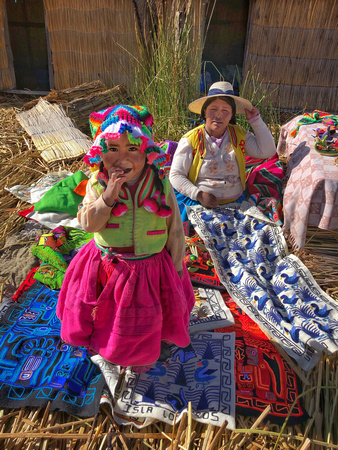 Colorful HandiworkLake Titicaca is one of South America's largest lakes and the world's highest navigable lake. Bordering both Peru and Bolivia, travelers to the lake discover both natural islands, made of earth, and man-made islands, made of reeds that grow at the bottom of the lake. Residents of the floating Uros Islands, or "Reed Islands", harvest the reeds from the lake and use them to build and maintain the islands themselves, as well as their homes, boats, furniture, and most everything they need to live on the islands. Residents of both types of islands maintain a way life resembling that of their Inca and pre-Inca ancestors.
Colorful HandiworkLake Titicaca is one of South America's largest lakes and the world's highest navigable lake. Bordering both Peru and Bolivia, travelers to the lake discover both natural islands, made of earth, and man-made islands, made of reeds that grow at the bottom of the lake. Residents of the floating Uros Islands, or "Reed Islands", harvest the reeds from the lake and use them to build and maintain the islands themselves, as well as their homes, boats, furniture, and most everything they need to live on the islands. Residents of both types of islands maintain a way life resembling that of their Inca and pre-Inca ancestors.
 Colorful HandiworkLake Titicaca is one of South America's largest lakes and the world's highest navigable lake. Bordering both Peru and Bolivia, travelers to the lake discover both natural islands, made of earth, and man-made islands, made of reeds that grow at the bottom of the lake. Residents of the floating Uros Islands, or "Reed Islands", harvest the reeds from the lake and use them to build and maintain the islands themselves, as well as their homes, boats, furniture, and most everything they need to live on the islands. Residents of both types of islands maintain a way life resembling that of their Inca and pre-Inca ancestors.
Colorful HandiworkLake Titicaca is one of South America's largest lakes and the world's highest navigable lake. Bordering both Peru and Bolivia, travelers to the lake discover both natural islands, made of earth, and man-made islands, made of reeds that grow at the bottom of the lake. Residents of the floating Uros Islands, or "Reed Islands", harvest the reeds from the lake and use them to build and maintain the islands themselves, as well as their homes, boats, furniture, and most everything they need to live on the islands. Residents of both types of islands maintain a way life resembling that of their Inca and pre-Inca ancestors.
 Photographing the Tourists?Lake Titicaca is one of South America's largest lakes and the world's highest navigable lake. Bordering both Peru and Bolivia, travelers to the lake discover both natural islands, made of earth, and man-made islands, made of reeds that grow at the bottom of the lake. Residents of the floating Uros Islands, or "Reed Islands", harvest the reeds from the lake and use them to build and maintain the islands themselves, as well as their homes, boats, furniture, and most everything they need to live on the islands. Residents of both types of islands maintain a way life resembling that of their Inca and pre-Inca ancestors.
Photographing the Tourists?Lake Titicaca is one of South America's largest lakes and the world's highest navigable lake. Bordering both Peru and Bolivia, travelers to the lake discover both natural islands, made of earth, and man-made islands, made of reeds that grow at the bottom of the lake. Residents of the floating Uros Islands, or "Reed Islands", harvest the reeds from the lake and use them to build and maintain the islands themselves, as well as their homes, boats, furniture, and most everything they need to live on the islands. Residents of both types of islands maintain a way life resembling that of their Inca and pre-Inca ancestors.
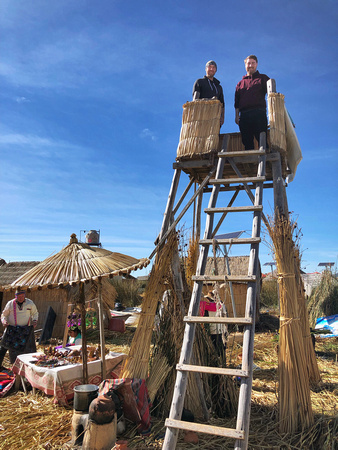 Communications TowerThe other islands are just a "call" away.
Communications TowerThe other islands are just a "call" away.
 Solar Panels...provide electricity on the islands.
Solar Panels...provide electricity on the islands.
Lake Titicaca is also home to natural islands (made of earth, as opposed to reeds). We visited one such island, Amantani - another island that sees few tourists, but much larger than the small reed island that we had just visited. Amantani is known for terraced fields, farming, and a quiet and remote lifestyle. Islanders speak Quecha and dress less colorfully – often in black or darker colors. We found them just as friendly and welcoming as the Aymara, however. We learned about life on the island and were treated to a home-cooked meal. We only visited the island for a couple of hours, but our hosts showed us guest rooms that they offer to tourists and invited us to return and spread the word. The three rooms were unoccupied at the time, but would certainly provide a relaxing respite for those looking to “get away from it all”.
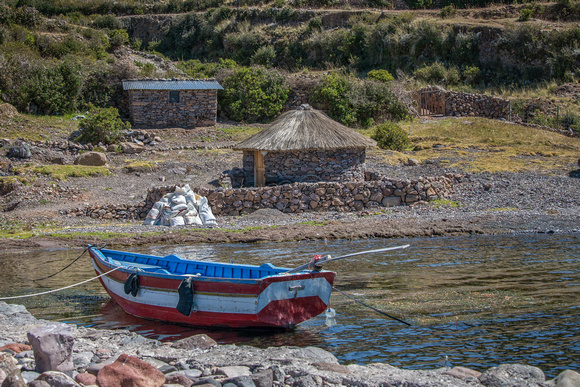 Amantani IslandLake Titicaca is one of South America's largest lakes and the world's highest navigable lake. Bordering both Peru and Bolivia, travelers to the lake discover both natural islands, made of earth, and man-made islands, made of reeds that grow at the bottom of the lake. Residents of the floating Uros Islands, or "Reed Islands", harvest the reeds from the lake and use them to build and maintain the islands themselves, as well as their homes, boats, furniture, and most everything they need to live on the islands. Residents of both types of islands maintain a way life resembling that of their Inca and pre-Inca ancestors.
Amantani IslandLake Titicaca is one of South America's largest lakes and the world's highest navigable lake. Bordering both Peru and Bolivia, travelers to the lake discover both natural islands, made of earth, and man-made islands, made of reeds that grow at the bottom of the lake. Residents of the floating Uros Islands, or "Reed Islands", harvest the reeds from the lake and use them to build and maintain the islands themselves, as well as their homes, boats, furniture, and most everything they need to live on the islands. Residents of both types of islands maintain a way life resembling that of their Inca and pre-Inca ancestors.
 Amantani IslandLake Titicaca is one of South America's largest lakes and the world's highest navigable lake. Bordering both Peru and Bolivia, travelers to the lake discover both natural islands, made of earth, and man-made islands, made of reeds that grow at the bottom of the lake. Residents of the floating Uros Islands, or "Reed Islands", harvest the reeds from the lake and use them to build and maintain the islands themselves, as well as their homes, boats, furniture, and most everything they need to live on the islands. Residents of both types of islands maintain a way life resembling that of their Inca and pre-Inca ancestors.
Amantani IslandLake Titicaca is one of South America's largest lakes and the world's highest navigable lake. Bordering both Peru and Bolivia, travelers to the lake discover both natural islands, made of earth, and man-made islands, made of reeds that grow at the bottom of the lake. Residents of the floating Uros Islands, or "Reed Islands", harvest the reeds from the lake and use them to build and maintain the islands themselves, as well as their homes, boats, furniture, and most everything they need to live on the islands. Residents of both types of islands maintain a way life resembling that of their Inca and pre-Inca ancestors.
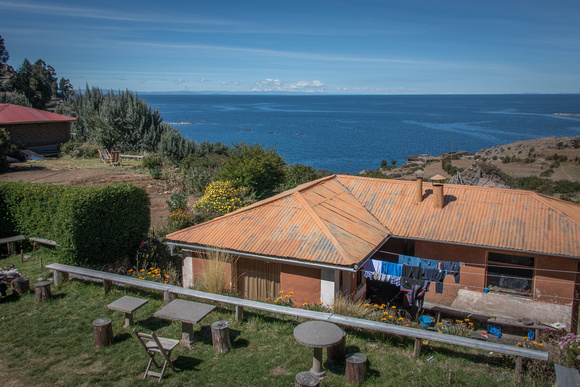 Amantani IslandLake Titicaca is one of South America's largest lakes and the world's highest navigable lake. Bordering both Peru and Bolivia, travelers to the lake discover both natural islands, made of earth, and man-made islands, made of reeds that grow at the bottom of the lake. Residents of the floating Uros Islands, or "Reed Islands", harvest the reeds from the lake and use them to build and maintain the islands themselves, as well as their homes, boats, furniture, and most everything they need to live on the islands. Residents of both types of islands maintain a way life resembling that of their Inca and pre-Inca ancestors.
Amantani IslandLake Titicaca is one of South America's largest lakes and the world's highest navigable lake. Bordering both Peru and Bolivia, travelers to the lake discover both natural islands, made of earth, and man-made islands, made of reeds that grow at the bottom of the lake. Residents of the floating Uros Islands, or "Reed Islands", harvest the reeds from the lake and use them to build and maintain the islands themselves, as well as their homes, boats, furniture, and most everything they need to live on the islands. Residents of both types of islands maintain a way life resembling that of their Inca and pre-Inca ancestors.
 Amantani Island... on Lake Titicaca
Amantani Island... on Lake Titicaca
 Amantani IslandLake Titicaca
Amantani IslandLake Titicaca
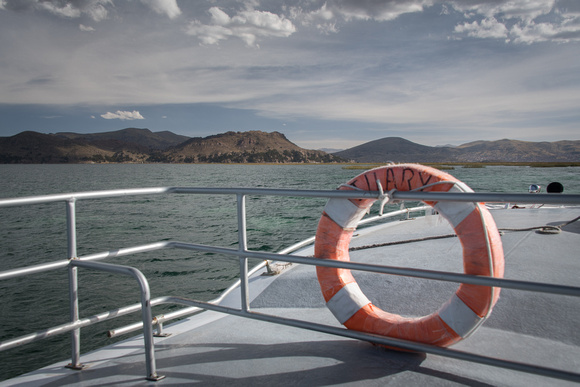 Sailing on Lake Titicaca
Sailing on Lake Titicaca
It was time to return to the hotel for the evening. We still had one last day in Peru, as our flight home did not leave until the following evening. We thought we might spend the day in Puno, but our guide offered another suggestion. It was perfect!
We began with a drive to Sillustani, about 20 miles outside of Puno and at the highest elevation of our trip, at 13,500 feet above sea level. The site offers incredible views above Lake Umayo. It is also the site of circular towers, or chullpas, built by the Colla civilization, an Aymara-speaking people conquered by the Incas about a century before the Spanish arrived. The towers served as burial chambers for entire families of nobility, along with their possessions, to take with them into the next world. It was one last example of the sophisticated architecture of an ancient civilization that has puzzled archaeologists and historians for quite some time.
 Lake UmayoSillustani is a pre-Incan cemetery used for Colla nobility on the shores of Lake Umayo near Puno in Peru.
Lake UmayoSillustani is a pre-Incan cemetery used for Colla nobility on the shores of Lake Umayo near Puno in Peru.
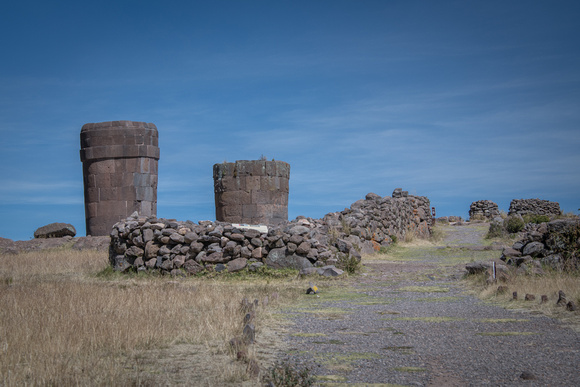 Chullpas, Burial Towersof Sillustani
Chullpas, Burial Towersof Sillustani
 Chullpaof Sillustani
Chullpaof Sillustani
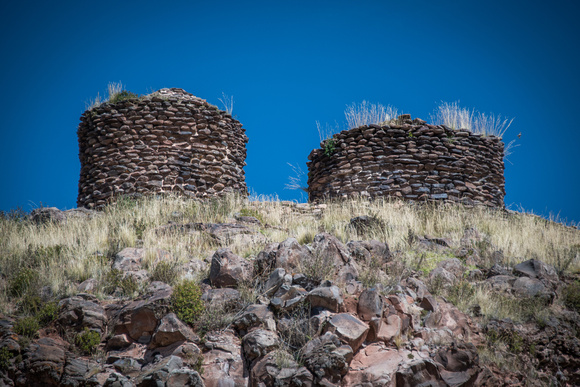 Chulllpasof Sillustani
Chulllpasof Sillustani
 Chullpaof Sillustani
Chullpaof Sillustani
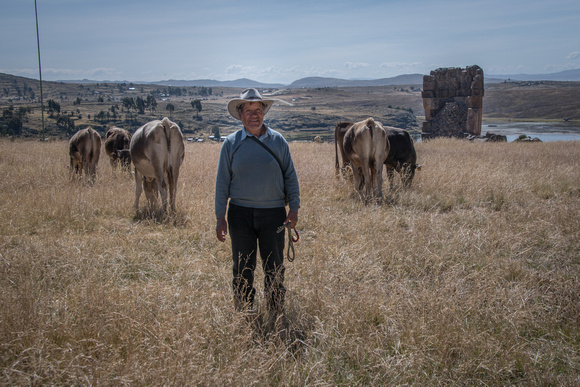 Cattle Rancherat Sillustani
Cattle Rancherat Sillustani
Our guide arranged one last stop - a visit with a family in a small community outside of Sillustani. They family’s alpacas greeted us on arrival.
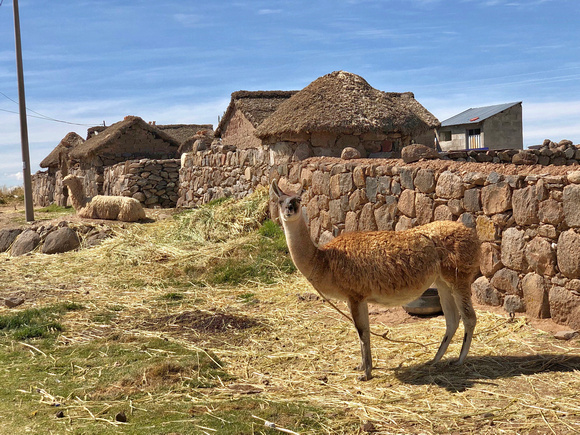 An Alpaca Welcomenear Sillustani
An Alpaca Welcomenear Sillustani 
The husband and wife were happy to show us weaving and farming techniques. The wife also showed us her outdoor kitchen with adobe oven. She had just finished making fresh cheese and offered us samples. It was delicious! Do you remember the cuy that we sampled in the Sacred Valley? As is common in the smaller communities of Peru, the couple also had an adobe-style pen of guinea pigs in the yard. She offered to let us feed vegetables to the animals that would one day be served as entrées on a special occasion.
 Rural LifeTwo cows above a doorway are good luck.
Rural LifeTwo cows above a doorway are good luck. 
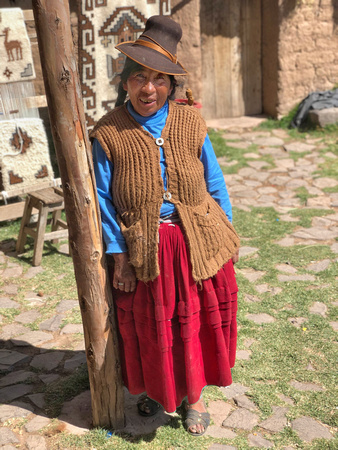 Another Warm Welcomenear Sillustani
Another Warm Welcomenear Sillustani
 Weavingnear Sillustani
Weavingnear Sillustani 
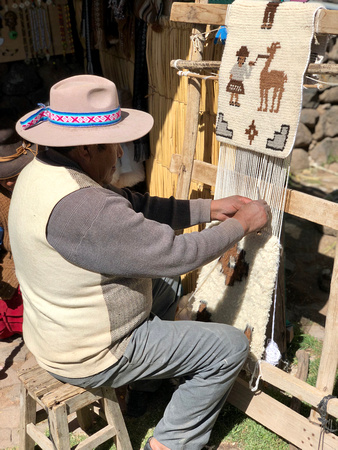 Weavingnear Sillustani
Weavingnear Sillustani
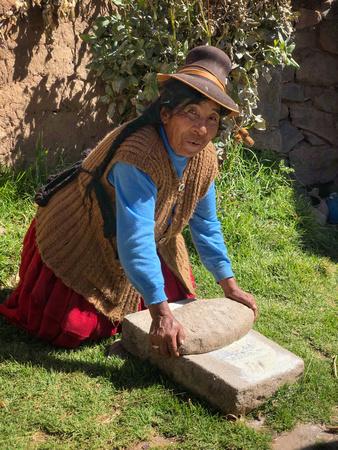 Preparing to Cooknear Sillustani
Preparing to Cooknear Sillustani 
 Farmingnear Sillustani
Farmingnear Sillustani 
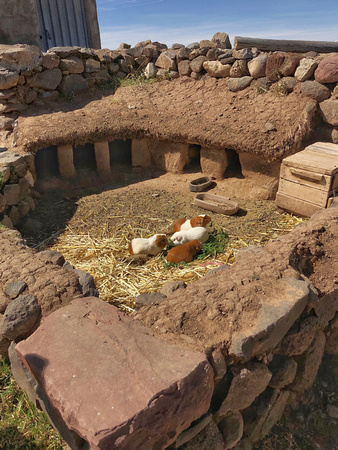 Guinea Pig Pen... future dinner entrees!
Guinea Pig Pen... future dinner entrees!
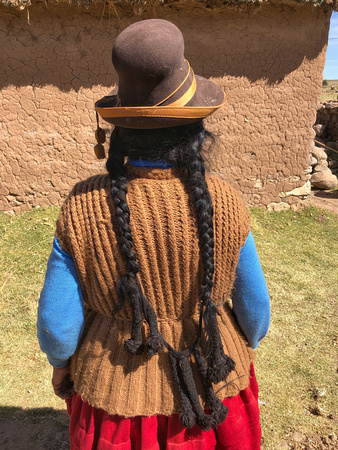 And she still has time to style her hair!
And she still has time to style her hair!
It was a memorable last day in Peru. Unfortunately, we didn’t have the time or budget for more. Other sites that tourists might wish to research are the Incan Trail, the “White City” of Arequipa, Colca Canyon, the Nazca Lines or Iquitos and the Amazon jungle. Clearly, Peru has an abundance of unique destinations to offer tourists. Click on the link for more images of any of the described destinations above.
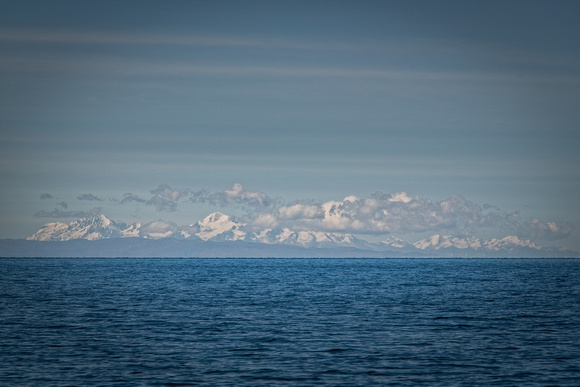 The Andes MountainsLake Titicaca is one of South America's largest lakes and the world's highest navigable lake. Bordering both Peru and Bolivia, travelers to the lake discover both natural islands, made of earth, and man-made islands, made of reeds that grow at the bottom of the lake. Residents of the floating Uros Islands, or "Reed Islands", harvest the reeds from the lake and use them to build and maintain the islands themselves, as well as their homes, boats, furniture, and most everything they need to live on the islands. Residents of both types of islands maintain a way life resembling that of their Inca and pre-Inca ancestors.
The Andes MountainsLake Titicaca is one of South America's largest lakes and the world's highest navigable lake. Bordering both Peru and Bolivia, travelers to the lake discover both natural islands, made of earth, and man-made islands, made of reeds that grow at the bottom of the lake. Residents of the floating Uros Islands, or "Reed Islands", harvest the reeds from the lake and use them to build and maintain the islands themselves, as well as their homes, boats, furniture, and most everything they need to live on the islands. Residents of both types of islands maintain a way life resembling that of their Inca and pre-Inca ancestors.